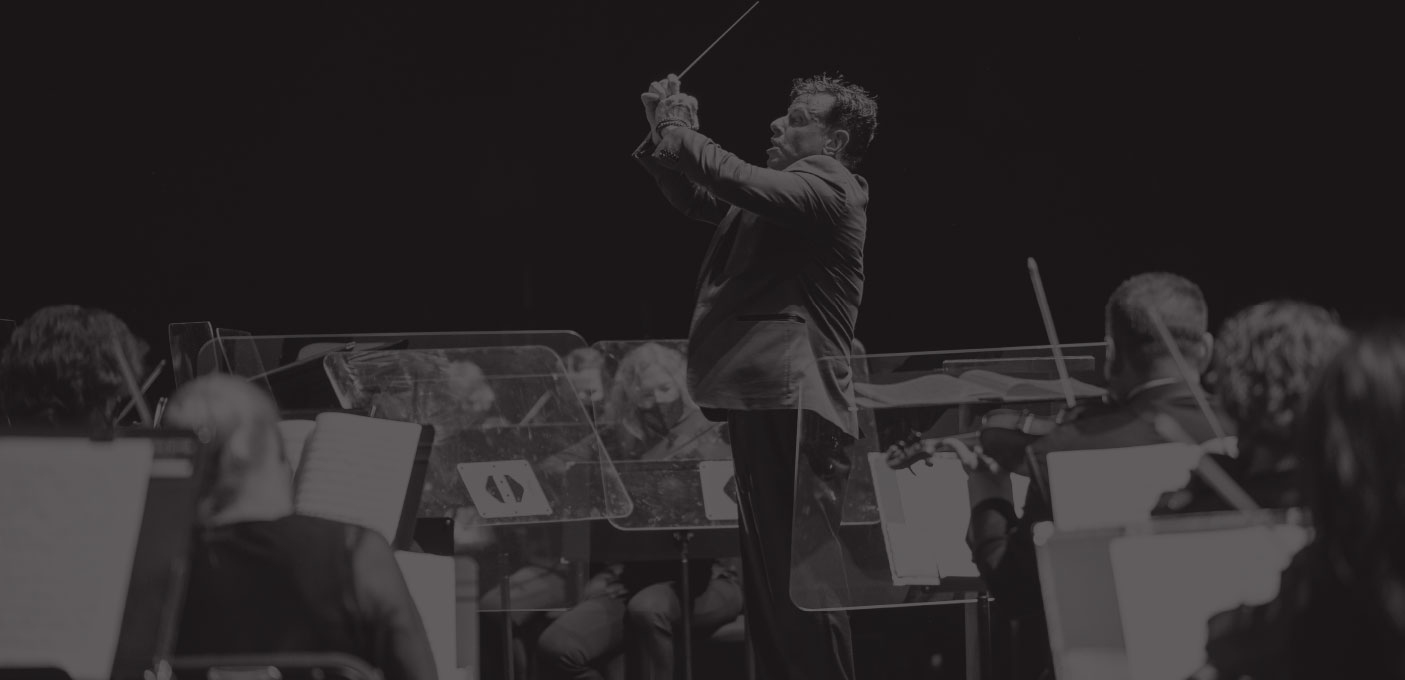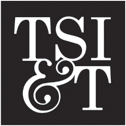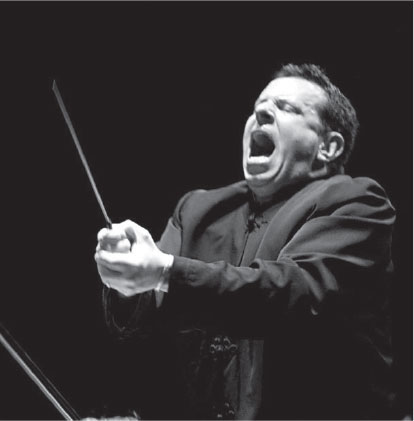Saturday, 30 January 2021
7:30 p.m. MST
(2021-01-31 1:30 a.m. UTC/GMT)
AARP HomeStream Your Helena Symphony
The Helena Symphony returns for Season 66 – Part Two by glancing back to more simple times. Copland’s Appalachian Spring captures the pioneering spirit of America, and more importantly, the sound and soul of a younger, more naïve country with a sense of a hopeful tomorrow. The concert concludes with the elegant charm of Stravinsky’s Pulcinella and his “discovery of the past” – a much-needed escape for us all.
Watch live on YouTube.
30 January 2021
Sinfonia (Overture) Serenata
Scherzino – Allegro – Andantino
Tarantella
Toccata
Gavotta con due variazioni
Vivo
Minuetto – Finale
This concert is sponsored in part by generous support from:
ALLAN R. SCOTT
Music Director & Conductor
Currently in his eighteenth season as Music Director of the Helena Symphony Orchestra & Chorale, Maestro Allan R. Scott is recognized as one of the most dynamic figures in symphonic music and opera today. He is widely noted for his outstanding musicianship, versatility, and ability to elicit top-notch performances from musicians. SYMPHONY Magazine praised Maestro Scott for his “large orchestra view,” noting that “under Scott’s leadership the quality of the orchestra’s playing has skyrocketed.”
SHARE AND VIEW YOUR PHOTOS LIVE!
Share your viewing party photos live on our PhotoStream. To get started, text ON to 406.412.2014.
View PhotoStream
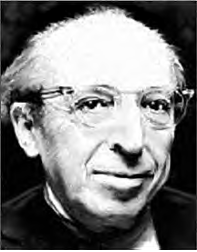
Parallel Events / 1944
Height of World War II in Europe and Pacific
Height of Holocaust
Franklin D. Roosevelt is elected for fourth term as U.S. President
Tennessee Williams’ play The Glass Menagerie premieres
Leonard Bernstein’s musical On the Town and ballet Fancy Free premiere
Bartok’s Concerto for Orchestra premieres
First open-heart surgery
Bandleader Glenn Miller dies in plane crash
AARON COPLAND
Born: Brooklyn, NY, 14 November 1900
Died: Peekskill, NY, 2 December 1990
“I felt that it was worth the effort to see if I couldn’t say what I had to say in the simplest possible terms.” –Aaron Copland
Standing as we do at the close of the American century, the hundred-year period during which the United States was for the first time a major power and contributor to the world economically, politically, and culturally, the question that composer Antonín Dvořák posed almost a century ago still remains for us: what is “American” music?
Ralph Vaughan Williams, the grand old man of English music, declared that music, above all other arts, is “the expression of the soul of a nation.” Today, Aaron Copland’s name is synonymous with “American music” more than any other composer, even more than George Gershwin or Leonard Bernstein.
With the musical world still quivering from the impact of Igor Stravinsky’s Rite of Spring (1913), Copland sought to recapture an America before the world wars; before its loss of innocence. By comparison, Leonard Bernstein depicted a postwar America, one increasingly divided along racial, religious, and political lines.
After studying with Rubin Goldmark (who studied with Dvořák) and Nadia Boulanger (a student of Gabriel Fauré), Copland learned, and eventually preached, the importance of finding one’s own musical voice. Like most composers of the late nineteenth and early twentieth centuries, Copland composed initially with little or no regard for the listener – composed for the sake of composing.
However, technological advances, such as the ability to permanently record live sound or broadcast it over airwaves, changed Copland’s way of listening to and ultimately composing music. Copland is, perhaps, the first major composer who finally realized and appreciated the importance of the listener beyond the concert hall. “I have every reason to be particularly grateful to the creator of the phonograph,” he said. “We composers owe a profound debt to Thomas Edison!”
This son of Russian Jewish immigrants quickly began to lead many of his fellow American artists in a commitment to capturing a wider audience and speaking to the concerns of the average citizen, the everyday American caught up in the dramas of the Great Depression and the Second World War. Copland responded to America’s calling for culture, pride, and patriotism. Though he represented the pinnacle of an intense mid-century Americanism, Copland was not an insular nationalist; on the contrary, he was acutely interested in world politics and in how the United States fit into the larger sphere.
On May 8, 1945 the headlines of the New York Times read: THE WAR IN EUROPE IS ENDED! America celebrated its military triumph over totalitarianism. It simultaneously emerged as a “super power” in the world along with the Soviet Union. Technology, weapons, and the will to go to war determined who was more “super.”
Ironically, the caption underneath the headline listed the Pulitzer Prize Awards for 1944 and Aaron Copland received the prize in music for his ballet score Appalachian Spring – the work that became a hallmark of Copland’s artistry and musical vocabulary. Appalachian Spring “has to do with the pioneer American spirit, with youth and spring, with optimism and hope,” said Copland. It affirmed why America entered the War, and audiences knew immediately and are still reminded what the country fought for when they saw and heard Appalachian Spring, even though it had no explicit patriotic theme. Copland’s collaborator, choreographer Martha Graham, not Copland, named the ballet Appalachian Spring after a line from a Hart Crane epic, The Bridge, declaring “O Appalachian Spring!”
Appalachian Spring
Appalachian Springballet score was originally composed for flute, clarinet, bassoon, piano, two first violins, two second violins, two violas, two cellos, and double bass.
The Suite was later composed for two flutes, two oboes, two clarinets, two bassoons, two horns, two trumpets, two trombones, timpani, xylophone, snare drum, bass drum, cymbals, tabor snare drum, wood block, claves, glockenspiel, and triangle.
When Graham asked Copland to compose a ballet that had “to do with roots in so far as people can express them, without telling an actual story,” Copland created the work, which he titled, Ballet for Martha. Composing the work for thirteen instruments, Copland employed wide-open intervals and octaves and a light instrumentation (primarily winds and strings) to achieve a transparent texture or “white-tone” as Copland called it.
The narrative of the ballet involved a pioneer celebration in the Pennsylvania hills around a newly built farmhouse during the early part of the nineteenth century. The principal characters are a bride and her young farmer husband and the story takes place within the time of one day, sunrise to sunset. Copland explains that while the creation of the score included “Graham’s interests in American roots and identity, the ballet’s enduring qualities stem more from a kind of poetic universality than from specifics of a time and place.”
Although the ballet is American in spirit, the plot is a love story. “It was Graham’s great genius,” explained Copland, “to retain the intensity of the relationship while idealizing and abstracting the Bride and Husband just enough so that they reach beyond themselves to express the springtime of the nation as well as the springtime in their own lives.” The result in the score was music with a quiet glow, a Puritan restraint, and the tenderness of young love, centered around the Shaker hymn, Simple Gifts or ‘Tis the Gift to be Simple.
Perhaps without realizing it, America, while basking in its new status in the world after the War, was also longingly looking back at its innocence and belief that if we just move a little farther west, we will find another beginning, another promise of tomorrow. In 1986 the U.S. Congress awarded Copland the Congressional Gold Medal recognizing Copland for his “his special achievement in creating a uniquely American style of composition, making a vital contribution to American artistic life.”
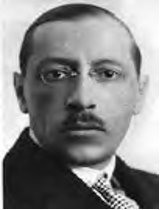
Parallel Events / 1920
League of Nations is established
U.S. gives women right to vote
Warren G. Harding is elected 29th U.S. President
Ravel’s Le Tombeau de Couperin premieres
George and Ira Gershwin write their first song
Philadelphia has first national Thanksgiving Day Parade
Joan of Arc is canonized a saint
Pope John Paul II, violinist Isaac Stern, Jazz musicians Dave Brubeck and Charlie Parker, actors Tony Randall, Yul Brynner, Walter Matthau, and Mickey Rooney are born
Good Humor ice cream bar is created
Belgium Godiva chocolates is founded
IGOR STRAVINSKY
Born: Oranienbaum, Russia, 17 June 1882
Died: New York, USA, 6 April 1971
In Paris, on 29 May 1913, the audience at a ballet rioted, stormed the stage, and prevented the performance from finishing.
Igor Stravinsky’s Le Sacre du Printemps (The Rite of Spring) is remembered not only because of it riotous opening night, but also because it single-handedly altered the course of Western music.
Because of works like Le Sacre, Stravinsky remains the most influential, most controversial, and most important composer (if perhaps not the most beloved) of twentieth century composers.
Educated at St. Petersburg’s University in criminal law and legal philosophy, this son of a prominent opera singer carved out his own unique path in music. After privately studying with composer Rimsky-Korsakov (who advised him against becoming a composer), Stravinsky began collaborating with ballet impresario, Serge Diaghilev. Between 1910 and 1913, Stravinsky composed three ballets that immediately ushered him to the forefront of modern music and made him the controversial crown prince of the avant-garde. In these ballets (The Firebird, Petrushka, and The Rite of Spring) Stravinsky composed music that conveyed barbarism and primitivism.
The essence of Stravinsky’s early compositional style of Stravinsky was rhythmic exploration. Using asymmetrical patterns and compound meters, the composer broke down traditional balanced phrasing. The pulse of the music was often unwavering, but unevenly accented and articulated.
Just as The Rite of Spring in a sense predicted or at least foreshadowed the chaos of World War I, so did Stravinsky’s compositional style after the War reflect the time. The end of World War I moved Stravinsky’s music into a sparer, pared-down style. With works such as L’Historie du Soldat, Tango, Ragtime, Pulcinella, and his oratorio Oedipus Rex, Stravinsky’s neo-classical period first seemed like an element of parody, but scholars have found in it a tendency toward “objectification,” like a Cubist collage with everyday objects painted by Picasso.
Stravinsky influenced more composers during the period between the two Wars than any other period during his lifetime, especially in the United States and France. He spent the last few years of his career experimenting with serialism (atonal music) inspired by composer Anton Webern, in such works as his Symphony in C and The Rake’s Progress.
In his last decade, Stravinsky achieved a surprising degree of celebrity, being feted by the Pope, the Kennedy’s, and, in a highly publicized return to Russia in 1962, by Nikita Khrushchev. Stravinsky died in New York and was buried, at his own request, near his friend Diaghilev on Venice’s cemetery island of San Michele.
Pulcinella: Suite
The Suite from Pulcinella was originally scored for piccolo, two flutes, two oboes, two bassoons, two horns, two trumpets, trombone, and divided strings, including solo string quintet.
Duration: 22 minutes
The Pulcinella ballet was conceived by Serge Diaghilev early in 1919 as a one act scenario that included vocals and dance episodes, with choreography by Leonide Massine and set and costume designs by Pablo Picasso. Diaghilev had collected manuscripts of works by or attributed to Baroque composer Giovanni Battista Pergolesi (1710-1736) on which the musical score for the ballet would be based. Stravinsky was not the first composer to be approached for the project (Manuel de Falla and Ottorino Respighi were initially involved). Stravinsky, however, chose not to reject the first paying job that Diaghilev had been able to offer him in five years.
The plot of the ballet is classically simple. The main character, Pulcinella, has captured the hearts of all the local girls. Enraged, the girls’ fiancés plot to kill Pulcinella, but he outwits them and substitutes a double who seems to die and then is “revived” by a disguised Pulcinella. When the girls’ fiancés return, Pulcinella arranges marriages for everyone, and he marries Pimpinella for the requisite happy ending.
Since the premiere at the Paris Opera on 18 May 1920, Pulcinella remains a popular favorite, especially the orchestral suite that Stravinsky extracted from the full ballet in 1922 and later revised in 1949 (he also arranged two suites for violin and piano, and one for cello and piano). Stravinsky’s score to Pulcinella was certainly timely, given the fashionable neo-classical styles that attracted so many composers around World War I (Prokofiev, Ravel, Respighi, and Richard Strauss). Stravinsky’s efforts to capture the sounds of two centuries before yield a masterpiece of wit and parody, and of tenderness and charm.
Stravinsky scholar Richard Taruskin aptly points out that “Pulcinella is far less an original composition – or even a re-composition – than a freewheeling and imaginative arrangement.” The original posters for the premiere performance accurately advertised Pulcinella as music by Pergolesi “arranged and orchestrated by Igor Stravinsky.” The score to the ballet consists of arrangements of whole pieces and movements, artfully stitched together to create self-contained scenes like little musical vignettes. Stravinsky’s revisions for the concert suite, however, are of crucial musical significance, taking the original musical phrases from the ballet by cutting, repeating, and overlapping them at will. He altered the original harmonies as well for the concert suite, adding new inner voices, repeated notes and chords, and provocative dissonances to give the music an unmistakably modern flavor. Stravinsky also distorted the original rhythms so that in place of the regular pulsations of baroque music, there are often quirky, angular, and irregular rhythms more reminiscent of – well, of Stravinsky!
Stravinsky rescored the music from the ballet for the concert suite with astonishing originality and sensitivity. Using a chamber orchestra of 33 players and writing to the highly discriminating standards of his own music, he created delectable sonorities inspired by contrasting textures of the Baroque era. As with the Concerto in E-flat, Dumbarton Oaks, composed almost twenty years later, Stravinsky’s model seems to have been Bach’s Brandenburg Concertos.
The end result of Stravinsky’s tinkering with the original score to Pulcinella for a concert suite is a polished work that superimposes unmistakably a Russian modernism on a Baroque foundation. “This stylistic jostling between the old model and its modern elaboration,” Taruskin points out, could only exist “in the land of Stravinsky’s musical imagining.”
“Pulcinella was my discovery of the past,” Stravinsky once said, “the epiphany through which the whole of my late work became possible. It was a backward look, of course – the first of many love affairs in that direction – but it was a look in the mirror, too.”

